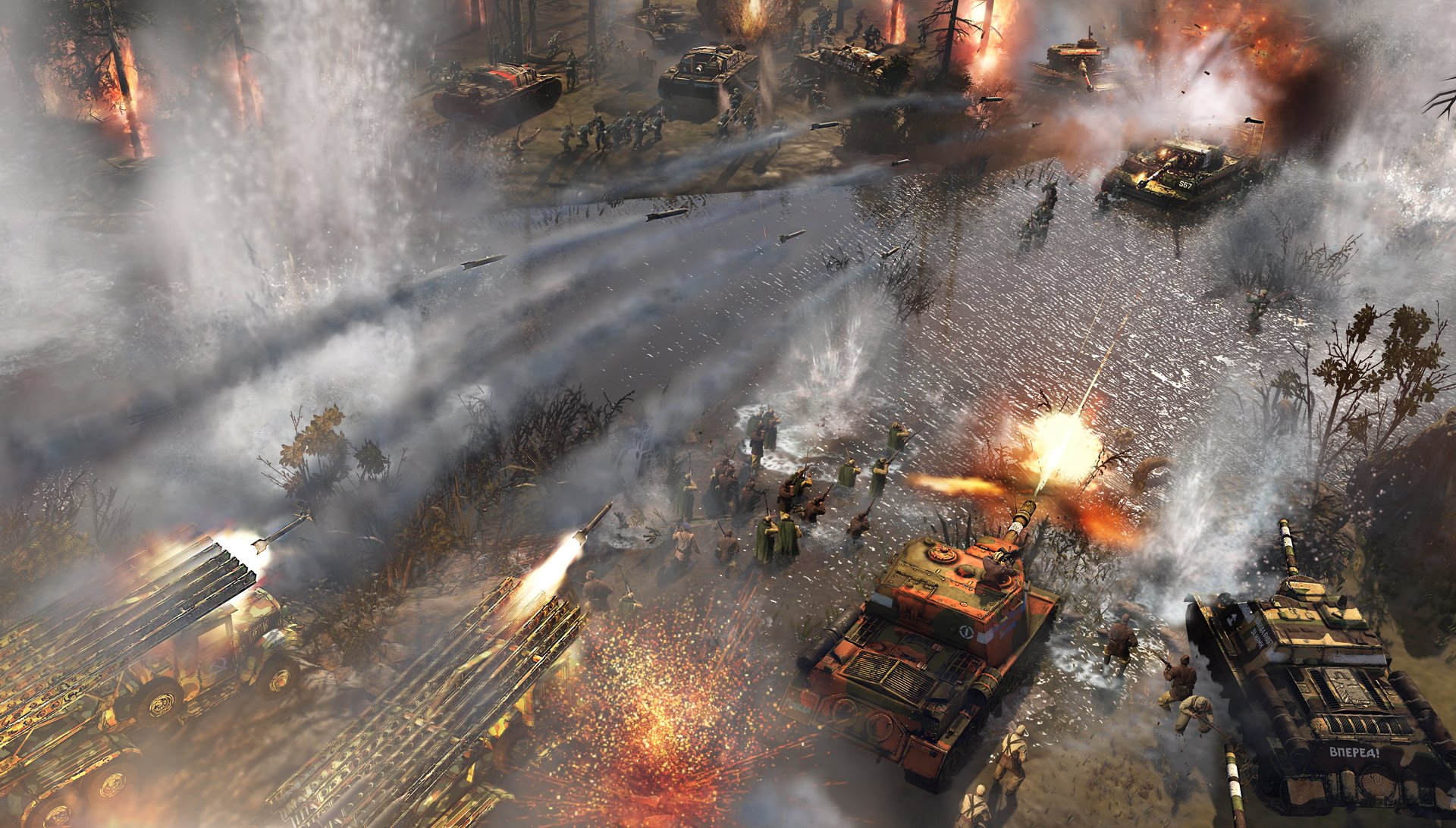Our Verdict
Company of Heroes 2 is the USSR of real-time strategy games: huge, powerful and just a little bit broken.
PC Gamer's got your back
It's called Company of Heroes 2 , but it's a long way into the 15-hour campaign before Relic's real-time strategy game finds any heroism. It's set on World War II's frigid Eastern Front, and is more concerned with rifle-butting home the horror of that bloodiest sector of the conflict. The Eastern Front saw the brunt of the war: Germany lost 80% of its Wehrmacht casualties east of Berlin; the Soviets themselves lost some 26 million souls overall, 8.6 million of whom were in the military.
"It's a long way into the 15-hour campaign before Relic's real-time strategy game finds any heroism."
Learning about this is harrowing; playing it is too. The Soviet war effort hinged on the country's ability to spit out prodigious amounts of young men and women to fight and die for their motherland. That quirk of population translates to game mechanics: as Soviet general-in-the-sky, I had a near-endless stream of people I could click on to send to their doom. In most missions, squads can be trained at your home base or brought into battle as conscripts. This second type of soldier gives Company of Heroes its Soviet tinge, and can sometimes make it unsatisfying to play.
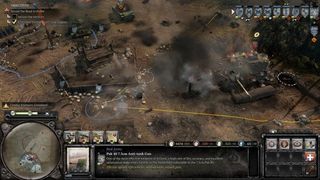
Squads are better trained, tougher and specialist in application. Encompassing groups as varied as mortar crews, snipers and shock troops armed with smoke and frag grenades, they formed the scaffolding of my armies on which I hung the meat of my forces: the conscripts. Conscripts can be brought in from the edges of the map every 30 seconds. At their lowest rank they're weak against almost everything, but they're quick to produce and essentially free, limited by just two of Company of Heroes 2's four resources: manpower – which is almost comically quick to regenerate on medium difficulty – and the population cap.
"Many missions allow you 135 tiny humans to reduce to bags of shot meat."
That population cap has increased since the first Company of Heroes, and many missions allow you 135 tiny humans to reduce to bags of shot meat. It feels like a lot: keeping track of an entire army is stressful, especially when many of the game's missions demand you fight on two fronts in addition to defending your base from roving groups of grenadiers. Having conscripts on tap mean these defences don't need to be particularly well thought out – my special tactics were as advanced as putting a set of men behind some sandbags, waiting for them to die as tougher enemies whittled them down, then sending in a second group to mop up the weakened foes.
But flitting between three skirmishes – each one taking place in a space wider than even the furthest-out zoom option can show – is draining. Doubly so when almost all of the game's units have a slew of personal abilities that can be activated in the heat of battle. Triply so when you're forced to cycle through eight different squads of milling men to find the one with the grenade that's off cooldown. Quadruply so when merging conscripts with existing squads in the heat of battle requires the kind of mouse precision that would have turned you into a Quake III professional at the turn of the millennium. Quintuply so when many missions impose time limits for completion, and kick you back to autosaves saved 30 minutes into an hour-and-a-half slog.
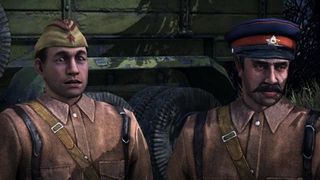
To avoid coming out of the campaign with actual PTSD, I found it easier to simply roll my forces into a ball – toughest units clustered at the middle, fleshy conscripts on the outside – and smash through enemy positions. Any lost conscripts could be replaced in seconds, and any lost soldiers could be too: conscripts have the ability to join up with a depleted squad to take them back up to their maximum complement. My tactic may have been historically accurate, but trying to drown your opponent in your own soldiers' blood isn't a particularly satisfying strategy to play out in a real-time strategy game.
"Company of Heroes 2's worst missions feel like they're backwards."
Company of Heroes 2's worst missions feel like they're backwards: instead of playing the plucky, clever underdogs, you're upgraded to the role of military colossus, infinite resources hurled at the brick wall until sheer erosion cracks a hole. It suffers most as a game when it's trying to tell its weighty story. Cutscenes tell the tale of Isakovich, a soldier turned journalist who documents the heroism of average men and women sent to their deaths. It's a worthy and true tale – one of traitors and egotists killing their own people – but it's almost entirely undone by cutscenes that look like they were made in 1945.
They're not rendered in the game's engine and they're not fancy CG, looking more like some terrible Xbox shooter, animated as if their actors were having their emotions signed to them off-stage a minute too late. Isakovich watches in Stalingrad as a commissar gives a machine gunner the order to shoot retreating troops. The gunner pauses for a moment before turning awkwardly on the spot, grinning like he's been told a joke, and shooting all his mates. There's historical poignancy in there but it staggers under clumsy delivery methods.

The burden of history weighs particularly heavily on the early quarter of the campaign. With the Germans pushing into Russia, the Soviet forces are in full retreat, meaning many missions aren't won so much as vacated. One asks you to flee the map, burning villages as you go. Another cast me into one final Soviet-held capture point with a broken and scattered force, before flashing up my next objective: 'hold out against waves of enemies: 0/10'. I managed to hold out against a glorious zero waves on my first go, and as my men were pulverised and the screen faded to black, I planned how better to spread them out to hold the line. I was surprised to see the words 'mission complete'. It certainly didn't feel that way.
But there is glory here, and there are heroes. Company of Heroes 2's quieter missions are its most memorable. One level in Polish territory gave me control of a super-sniper and a few squads of her resistance chums. Unlike most squads, the snipers would hold fire until directly ordered to shoot, making traversing the Polish forests a pleasingly efficient military exercise: move one set of snipers to the treeline to provide cover for another leapfrogging duo, before destroying an enemy squad with six carefully aimed bullets fired in a single devastating salvo.
"there is glory here, and there are heroes."
Another level deposited me and a handful of ill-equipped conscripts in a freezing town, asking us to take down a near-indestructible Tiger tank with ingenuity and planning. This mission made good use of Company of Heroes 2's true line-of-sight: without eyes on my tanky target, I was left bumbling around in the cold. After a few of my squad were squished under its 70-tonne tracks, I began to lay down tripwires and traps. Eventually crippling the big bastard caused a real-life fistpump, a gesture repeated when I got to shoot its driver, commandeer it, patch it up and drive it home. These levels show CoH2's moving parts working to drive the war machine forwards.
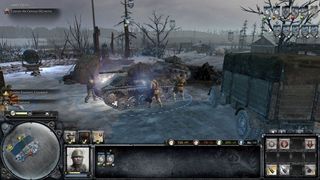
They don't always do that, though. The game is loaded with half-explained and unintuitive systems. Four resources – manpower, fuel, munitions and population cap – determine whether you'll be able to call in new troops and vehicles. Of these, I ran out of munitions most regularly, using the red-coloured numbers to perform special abilities such as launching sniper flares or sending IL2 fighter-bombers on strafing runs. Too often I sat around outside enemy encampments, waiting for my munitions to tick up to the point I could destroy my opponents in one barrage, rather than pick my way through a fortified position on foot.
"The game is loaded with half-explained and unintuitive systems."
Conscripts come in three distinct flavours: fresh ones are flimsy meat shields; Frontivik conscripts can be outfitted with close-range SMGs and Molotov cocktails; and penal battalions are almost the equal of trained soldiers. Calling conscripts into battle also furnishes your home base with a commissar for a time. Retreat a broken unit back to your home base with this commissar active, and he'll shoot the deserters – an act that, for some crazy reason, increases your progress toward unlocking better conscripts.
Relic want you to jettison the remnants of battered squads, trading them off for better upgrades as the mission goes on, but the process isn't properly explained or justified. It's completely counterintuitive, the kind of design decision that should've been summarily shot in the head at an early stage in development: especially when the layout of some bases meant my cowardly retreaters were able to hide behind buildings to stay out of the commissar's eyeline and avoid the death penalty.
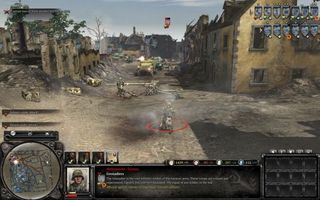
There are other niggles. Penal battalion soldiers have satchel charges by default, and can be outfitted with rifle grenades at your home base. Both abilities are set to E. Pressing the hotkey in battle seemed to select one of the abilities at random, so that if I wanted to pop a tank with an infantry crew, I'd have to locate the squad I needed, click the ability and place the charge – all with the mouse – by which point the tank I was trying to destroy had usually spotted me fiddling with my explode-o-bag and buggered off.
"CoH2's AI is a bit suspect."
That's if it was able to process that much information. CoH2's AI is a bit suspect, leading to some confusing scenarios. I'm no expert in mechanised warfare, but I don't think the Wehrmacht's primary tank tactic on spotting enemy vehicles was to jam their steel charges into high gear and trundle towards the foe like affectionate puppies, stopping a few metres short with their thinly-armoured arse flapping in the freezing breeze.
It almost makes sense for the Germans' heavier tanks to perform such ramming manoeuvres, but then the little tank destroyers have a tendency to do it too. German soldiers display a similar level of battlefield awareness, struck by a Wehrmacht-wide case of short-term memory loss. Grenadiers will hit the ground as one of their number is shot in the neck by a sniper, only to pop back out of cover a minute later, having forgotten about the leaking corpse that used to be Jürgen lying in the dirt next to them.
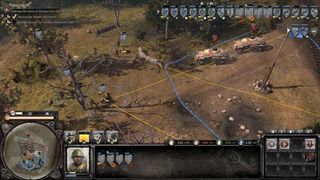
Pathfinding was also a problem for some of my troops. Had I not intervened when an anti-tank gun's turret stretched a few metres past an overhang, I think most of the Red Army would still be stranded east of Warsaw. Luckily, these are the only technical problems: the game ran smoothly on mid-range AMD and Intel CPUs, and came with the suite of graphical options you'd expect from such a PC-centric title.
"I was driving the steamroller inexorably closer to Berlin."
Even that weak enemy AI is less of a problem than you'd expect. After the retreats of the campaign's first third, the Red Army has time to coalesce and push back. For much of the rest of the story I was driving the steamroller inexorably closer to Berlin. Enemies in my path were like locks that I could choose to either smash through or delicately unpick. Against tougher foes, both approaches felt good.
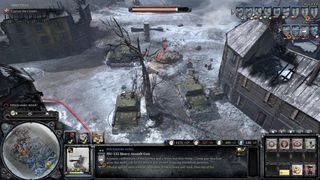
Even better are CoH2's Theatre of War missions. These are focused fights split into three categories: co-op scenarios, solo challenges and AI battles. Where Isakovich's campaign story spans 14 missions, the Theatre of War has 18 missions for 1941 alone – the years progress as more battles are won – split between the German and Soviet sides. Where the main campaign can be bloated, these missions are exhilarating in their singular focus and multiple options. I played one solo challenge that asked me to level German buildings with long-range Katyusha rocket trucks supported by a small contingent of troops. On my first go I careened around the map, launching barrages before sacrificing squads to allow the Katyushas to escape. On my second attempt I worked out a solid firing solution and parked up in the middle of the level, able to rain rockety doom down on the marked buildings as my dug-in conscripts kept my Katyushas firing. Both attempts were successful.
"Co-op is Company of Heroes as an aggressive kid's toybox."
Co-op missions are similarly freeform. Both generals can choose to mix and match similar forces and push together on their objectives, or to coordinate and specialise. This is Company of Heroes as an aggressive kid's toybox, allowing you to either pull out your favourite soldiers to win the fight your way, or asking you to battle back against almost-overpowering odds in a way the campaign rarely does.
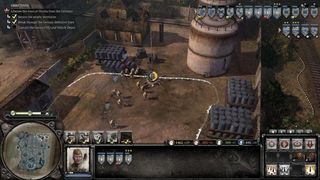
"I've already plotted how I'm going to go back and kill the next 250 tiny, pretend people."
I found most of the character and cleverness that was missing from CoH2's campaign mode in these Theatre of War missions. I found yet more in the game's multiplayer: replacing the game's slightly wonky AI with real humans makes for ludicrously tense matches, even if a few tactics – mortar spam, particularly – feel entirely too effective for their own good. Both Theatre of War missions and multiplayer matches feed back into a central character: your own general, an upgradeable fellow who can select his combat bonuses, signature units and vehicle camouflage.
I went for a shock specialist for his ability to field flamethrower tanks: nasty little brutes that can rumble into fortified positions before squirting out jets of fire. Generals have buffs and boosts that can be switched out once you've unlocked them – my Soviet Guards now have a 5% health increase after I used the unit to kill 40 Panzer Grenadiers – creating a compulsion loop that means I've already plotted how I'm going to go back and kill the next 250 tiny, pretend people.
And despite the niggles and deficiencies I've pointed out here, I do want to go back and kill them. CoH2 takes its lessons from history very literally. Like the Red Army it depicts, it wages its war by throwing everything forward at once, and like that Red Army, too many casualties were left to die along the way. It's sometimes clumsy, a game that can't maintain all its systems, with too many disparate moving parts to feel consistently coherent. But the final result, despite the small losses along the way, is a winner.
- Expect to pay: £40/$60
- Release: June 25th
- Developer: Relic Entertainment
- Publisher: Sega
- Multiplayer: Up to 4v4
- Link: www.companyofheroes.com
Company of Heroes 2 is the USSR of real-time strategy games: huge, powerful and just a little bit broken.

Today's Wordle answer for Saturday, November 9

Genshin Impact's missing English voice acting returns in its latest trailer, but players aren't sure if they should celebrate yet

Palworld developer reports Nintendo's suing over 3 Pokémon patents for only $66,000 in damages, but a videogame IP lawyer says fighting the lawsuit could mean 'burning millions of dollars'
